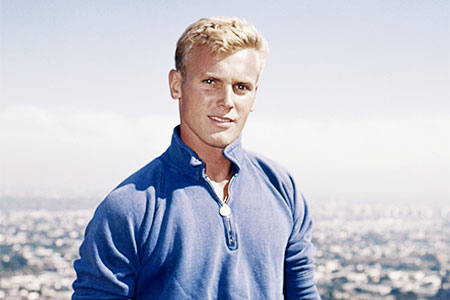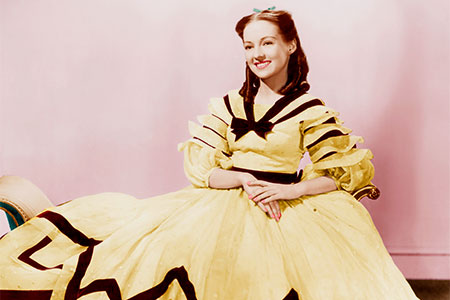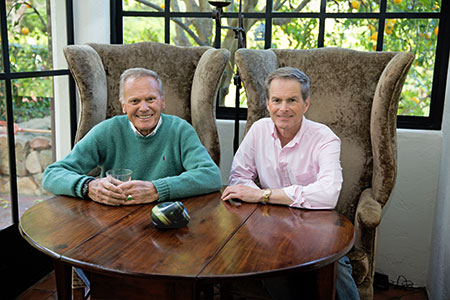A Sculpture with a Lifetime of History
by Natasha Wolff | December 23, 2015 11:50 am
Towering green hedges flank an imposing wrought-iron gate, which opens to reveal an acre of verdant, manicured lawn surrounding a white Spanish stucco structure with a rolling red-tile roof. The scene could accurately be described as the very essence of Southern California architecture, so it’s fitting that nestled inside is the sanctuary of Tab Hunter, the 1950s matinee idol once considered Hollywood’s quintessential All-American boy, and Allan Glaser, a film producer and Hunter’s partner of nearly three decades.
It’s been more than 20 years since the couple left behind Los Angeles for the only slightly less starry Santa Barbara suburb of Montecito, where both Oprah Winfrey and Ellen DeGeneres are neighbors. Here the men lead a simple life: In the mornings, they either take their two Whippets, Hattie and Olivia, for a run on the nearby beach or Hunter will visit his beloved horse Harlow in a stable a short distance away. Some days the couple will have lunch at a café in town. Every Sunday, Hunter faithfully attends service at his local Catholic church.

Vintage Hunter
If Hunter, still charismatic at 83, ever feels nostalgic for his days in the spotlight, he need only look around the capacious residence at an array of artifacts from his career on display. “The furnishings[1] are things I’ve acquired from my travels all over the world,” Hunter says. “They’re wonderful memories of people and places I’ve known.”
And what a group that’s been. During his career as one of Warner Brothers’ top stars, Hunter competed against James Dean and Paul Newman for roles, escorted Natalie Wood on studio-arranged dates and even maintained a recording career, releasing the hit “Young Love,” which eventually led to the formation of Warner Bros. Records. Hunter detailed his rise to fame—including romances with Anthony Perkins and Rudolf Nureyev—in his 2005 best seller, Tab Hunter Confidential, and a documentary of the same name is currently on the festival circuit.
In Montecito, there are mementos[2] of Hunter’s success in every room. A pair of Gothic chairs in the foyer remind him of his late friend Rock Hudson, to whom they once belonged. An antique table in the next room was a gift from the British banking heir Evelyn Baring. There are also plenty of equestrian[3] paintings throughout the home, a tribute to Hunter’s lifelong love of horses.
Yet perhaps the most extraordinary object in the house—and certainly the most valuable—is Magatama, a sculpture designed by the late Isamu Noguchi. At first glance, it’s a rather unassuming work: a comma-shaped piece of black onyx highlighted by pale green stripes across the center, less than six inches in length. It could be mistaken for a paperweight, as it sits in the middle of the living room on a coffee table (not one of Noguchi’s) next to a bronze horse figurine. Hunter refers to it as “the marble kidney,” while Glaser jokes that it could easily pass for a knickknack from Mexico. Yet the sculpture was recently appraised at half a million dollars—and it comes with a surprising Hollywood pedigree.

Gone with the Wind-era Keyes
Magatama came into Hunter and Glaser’s possession thanks to a coin toss. It began with the couple’s friend, the actress Evelyn Keyes, who was best known for playing Scarlett O’Hara’s younger sister in Gone With the Wind. Keyes was by all accounts a spirited blonde and an avid art enthusiast. In 1946, following a whirlwind courtship, Keyes married movie director John Huston, renowned for his own impressive pre-Columbian collection, and while honeymooning on the East Coast the newlyweds visited the New York studio of Noguchi, who gifted them the heavy, twisting sculpture.
After Keyes and Huston divorced in 1950, they stayed friendly and split their entire art collection evenly. When both parties found themselves in Spain not long after the break-up, Huston was feeling sentimental about their amassed collection and proposed flipping a coin, with the winner taking all the art. Huston lost the bet, and Keyes found herself the proud owner of pieces by Picasso, Rufino Tamayo and Paul Klee, as well as a massive assemblage of pre-Columbian art.
A few years after, when Keyes became engaged to film producer Mike Todd, she offered him the Noguchi as an engagement gift. Three weeks after that, Todd announced he’d fallen in love with Elizabeth Taylor and returned the sculpture to the jilted Keyes. She went on to marry famed bandleader Artie Shaw, who would, after retiring, sell without Keyes’ consent her furs, jewels and art collection. Somehow the Noguchi escaped his notice and remained with the actress until her death in 2008, after which it was bequeathed to Glaser, who’d looked after Keyes in her final years.
Despite the sculpture’s value and provenance, the couple doesn’t keep it under lock and key. In fact, when an appraiser recently visited to examine the piece, she found it stowed inside a thick rubber container.

Hunter and Glaser with Magatama
“It made sense that if it fell, it would be cushioned,” Glaser says with a laugh. “But she told me that only in California would someone store a Noguchi in Tupperware.”
Its modest repository notwithstanding, the value of the sculpture came as no surprise to either man, since Keyes had described it as her treasure. “Evelyn told me it’s better than gold sitting in a bank,” Glaser recalls. “She would have never sold it. Its sentimental value to her was priceless.”
It’s fitting, then, that while the piece has landed in the hands of yet another silver-screen luminary, it’s perhaps with the safest star of them all—one who walked away.
- furnishings: http://dujour.com/design/bold-new-marble-furnishings/
- mementos: http://dujour.com/tag/antiques-collectibles/
- equestrian: http://dujour.com/style/hermes-equestrian-collections/
Source URL: https://dujour.com/culture/tab-hunter-magatama-isamu-noguchi-sculpture/